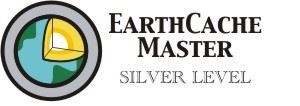




Wow, what a morning! We planned a stopover in the city of Riobamba, Ecuador while returning to Quito from the southern part of the country. We grabbed a hotel and tried to get a good night's sleep in order to get away early the next morning to go for a regular and an earthcache on Chimborazo Volcano. The good night's rest was wishful thinking but the weather and the hike to the two caches on the volcano was great. When we came outside of our hotel we were blown away by the majesty of the volcano. There wasn't a cloud in the sky around it. We drove west and slightly north making our way higher with each passing kilometer. The paved rural road took us through small Quichua Indian communities. The bright colored Quichua dress of the women shepherds stood out against beautiful, lust green pasture land. Soon we climbed up above the grazing land and even above the treeline. As we climbed we could see the many layers of ash fall where the road cut through the hills. Now the terrain was barren and windswept. Eight kilometers short of the first refuge hut we turned off the pavement and onto a dirt road. We paid our entrance fee ($10 US for tourist and $2 for residents of Ecuador) and continued the climb. While weaving our way up the side of the volcano we could see El Altar and Tungurahua volcanos in the distance. El Altar was covered in snow and shining brightly in the sunlight. Tungurahua was in erruption. From our vantage point high above the valley we could see the smoke spewing out in the distance. We arrived at the first hut without even going into 4 wheel drive. We parked the car, put on another layer of clothing and tracked the needle to the first cache. Whymper (GC1ZE8J) was a small tuppeware box with a few items of swag. It was well hidden from muggles but an easy find at 15,500 feet or so above sea level. I suspect that on most days the cloud cover would have hidden anyone looking for the cache from the view of muggles at the hut. Today we had to use stealth as the sky was clear. After signing the log and replacing the cache we headed out to hide a cache and find the second cache. As we climbed we stopped to read the Simon Bolivar monument, written in Quichua and Spanish. It proclaims how the great liberator of Ecuador and much of northwestern South America climbed to an unspecified point on the volcano in the early 1800's. Just beyond this monument was another field of monuments of sorts. These are the stones, much like gravestones, remembering those who have lost their lives on Chimborazo. I made this climb with sumajhuarmi. I have to tell you that she is an athlete. She's a runner and in good shape. She runs circles around me. I don't stand a chance on level ground with her. But on the mountain I had the advantage. The last time I climbed I weighed in at 40 lbs heavier than I am today. I could really feel the difference! Climbing was a lot easier. We pushed to make the climb between the two refuge huts in 42 minutes. Not bad. This include a stop mid way to hide a cache. Check out Between Huts (GC2FWBX). While you can claim the earthcache without going to the second hut, this traditional cache will require you go at least half way up. Once there you'll be sure to make it the rest of the way. Once at the second hut we visited with a group of Czech climbers. They were waiting on eleven of their countrymen who had summited Chimborazo in the morning hours and were working their way back down. The hut is a warm refuge from the cold and a place for climbers to acclimate to the elevation before summiting. You can grab a coffee or tea inside and warm you fingers before heading down. On many days the weather is much colder and the visibility worse. Some come up in blowing snow and sleet. We were fortunate as the photos show. Once at the hut we completed the requirements for the earthcache. We topped out above 16,500 feet according to the GPSr. I won't be too specific as reporting the elevation is one of the logging requirements for the earthcache. Check out Chimborazo (GC1F1GF) for more details. As we began our descent the mountain began to slip from view as the clouds came in from the east. The temperature began to drop so we picked up our pace down the mountain. Chimborazo is the highest mountain on the planet as measured from the center of the earth. If you come to Ecuador I suggest you make it one of your visits!

No comments:
Post a Comment